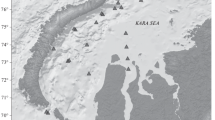Summary
-
1.
From 2 days before to 2 days after moulting crayfish do not feed. By means of repeated analyses of all important body constituents and metabolites a balance sheet of metabolism was made for this time intervall (Tables 1 and 2).
-
2.
Within the last 36 hours before moulting a crayfish of 20 g body weight absorbs 330 mg of chitin out of the old integument. Of these, 50 mg are oxidized to CO2, 120 mg are used for the synthesis of new chitin, and the remainder are stored in the form of lipids (40 mg), polysaccharides (40 mg) and free or proteinbound amino acids (80 mg).
-
3.
Within the first 48 hours after moulting these stores are completely exhausted for the use of energy metabolism and the synthesis of more chitin. The reabsorbed chitin is the only source of energy for metabolic demands during the period of starvation; other reserves are not affected.
-
4.
Just after moulting the concentration of free amino acids rises 80% apparently in connection with the increase in body volume due to the osmotic influx of water. The concentration of glutamic acid increases from zero to 27 μMol/animal.
Zusammenfassung
-
1.
In dem Zeitraum 2 Tage vor bis 2 Tage nach der Häutung nehmen die Flußkrebse keine Nahrung auf. An 4 Tiergruppen wurde der Chitingehalt, die einzelnen organischen Reservesubstanzen und verschiedene Metabolite quantitativ bestimmt und eine Stoffwechselbilanz aufgestellt.
-
2.
Während der letzten 36 Std vor der Häutung werden von einem 20 g schweren Krebs etwa 330 mg Chitin resorbiert und im Lipid (40 mg), Polysaccharid (40 mg) und den freien und proteingebundenen Aminosäuren (80 mg) gespeichert bzw. zur Synthese von Chitin (120 mg) und für den Energiestoffwechsel (50 mg) verbraucht.
-
3.
Innerhalb von 48 Std nach der Häutung werden die Speicher weitgehend abgebaut um weiteres Chitin zu synthetisieren. Energiestoffwechsel und Chitinsynthese werden während des gesamten Meßzeitraums aus dem resorbierten Chitin bestritten.
-
4.
Die Konzentration der freien Aminosäuren wird bei der Häutung offenbar im Zusammenhang mit der Vergrößerung des Körpervolumens durch Wassereinstrom um 80% erhöht. Die Konzentration der Glutaminsäure steigt zur gleichen Zeit von 0 auf 27 μMol/Tier.
Similar content being viewed by others
Literatur
Andrews, P.: Über den Blutchemismus des Flußkrebses Orconectes limosus und seine Veränderungen im Laufe des Jahres. Z. vergl. Physiol. 57, 7–43 (1967).
Bade, M. L., Wyatt, G. R.: Metabolic conversions during pupation of the cecropia silkworm. I. Deposition and utilization of nutrient reserves. Biochem. J. 83, 470–478 (1962).
Collatz, K.-G.: Das Lipidspektrum des Flußkrebses Orconectes limosus und seine jahreszeitlichen Veränderungen. Z. vergl. Physiol. 65, 274–290 (1969).
—, Speck, U.: Gesamtbestand an organischen Substanzen der Spinne Tegenaria atrica im Vergleich zu Protophormia terrae novae (Diptera) und Orconectes limosus (Crustacea, Decapoda). Z. vergl. Physiol. 70, 35–44 (1970).
Crompton, M., Birt, L. M.: Changes in the amounts of carbohydrates, phosphagen, and related compounds during the metamorphosis of the blowfly, Lucilia cuprina. J. Insect Physiol. 13, 1575–1592 (1967).
Drach, P.: Mue et cycle d'intermue chez les Crustacés Décapodes. Ann. Inst. océanogr. (Monaco) N. S. 19, 103–391 (1939).
Duchâteau, G., Florkin, M.: Système intracellulaire d'acides aminés libres et osmorégulation des Crustacés. J. Physiol. (Paris) 48, 520 (1956).
—, Jeuniaux, C.: Composante amino-acides des tissus chez les Crustacés. I. Composante amino-acide des muscles de Carcinus maenas L. lors du passage de l'eau de merà l'eau saumâtre et au cour de la mue. Arch. int. Physiol. Biochim. 67, 489–500 (1959).
Florkin, M., Schoffeniels, E.: Euryhalinity and the concept of physiological radiation. In: Munday, K. A., Studies in comparative biochemistry. Oxford: Pergamon Press 1965.
Lang, R.: Monosaccharidumwandlung und Chitinsynthese bei dem Flußkrebs Orconectes limosus. Diss. Berlin 1970.
Renaud, L.: Le cycle des réserves organique chez les Crustacés Décapodes. Ann. Inst. océanogr. (Paris), N.S. 24, 259–357 (1949).
Scheer, B. T.: The hormonal control of metabolism in crustaceans. IX. Carbohydrate metabolism in the transition from intermoult to premoult in Carcinides. Biol. Bull. 116, 175–183 (1959).
Siebers, D.: Mechanismen der intrazellulären isosmotischen Regulation der Aminosäurekonzentration bei dem Flußkrebs Orconectes limosus. Diss. Berlin 1970.
Skinner, D. M.: Amino acid incorporation into protein during the molt cycle of the land crab, Gecarcinus lateralis. J. exp. Zool. 160, 225–233 (1965).
Speck, U.: Das Kohlenhydratspektrum in den Organen des Flußkrebses Orconectes limosus und seine Veränderungen im Jahresablauf. Z. vergl. Physiol. 65, 51–69 (1969).
—, Urich, K.: Das Schicksal der Nährstoffe beim Flußkrebs Orconectes limosus: Einbau von Glucose-U-14C, Glutamat-U-14C und Palmitat-U-14C in die verschiedenen Stoffklassen. Z. vergl. Physiol. 63, 395–404 (1969a).
—: Der Abbau körpereigener Substanzen in dem Flußkrebs Orconectes limosus während des Hungerns. Z. vergl. Physiol. 63, 410–414 (1969 b).
- -Das Schicksal der Nährstoffe bei dem Flußkrebs Orconectes limosus. III. Chemische Umwandlung U-14C-markierter Nährstoffe in den resorbierenden Geweben. In Vorbereitung (1971).
Author information
Authors and Affiliations
Additional information
Mit Unterstützung der Deutschen Forschungsgemeinschaft. Für die sorgfältige Durchführung der Messungen danken wir Frau R. Hahmann.
Rights and permissions
About this article
Cite this article
Speck, U., Urich, K. Quantitative Bedeutung der Reservestoffe für Chitinsynthese, Energiestoffwechsel und osmotische Vorgänge während der Häutung des Flußkrebses Orconectes limosus . Z. Vergl. Physiol. 71, 286–294 (1971). https://doi.org/10.1007/BF00298140
Received:
Issue Date:
DOI: https://doi.org/10.1007/BF00298140



